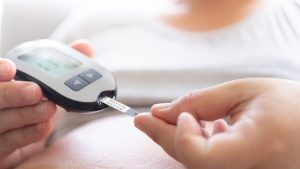Articles / When is a mammogram not enough?

At a population level, mammographic screening every two years for women aged 50 to 74 aims to increase early breast cancer detection rates and has been shown to reduce breast cancer death rates. But while this standard screening has been successful, some people may benefit from screening from a younger age, at more frequent intervals, or using additional tests beyond mammograms, explains Dr Melissa Bochner, a breast surgeon and Head of the Breast Endocrine Unit at Royal Adelaide Hospital.
There are two groups in which non-standard screening should be considered, Dr Bochner says. The first is women with a high risk of developing breast cancer, particularly those who are too young for standard screening.
This includes women with a known gene mutation, Dr Bochner says, noting that in a Royal Adelaide Hospital series, these women were diagnosed at “a median age of 41, with a range between 29 and somewhere in the 70s, so they clearly need to start screening sooner than 40.”
“The same would apply for a woman with a strong family history of breast cancer, particularly if a family member has been diagnosed at a young age,” she says, along with women who’ve had radiotherapy to the breast, particularly mantle radiation for lymphoma during childhood or young adulthood.
The second group includes women with mammograms that are hard to read, either due to high breast density or technical issues such as positioning difficulties, complicated silicone implants, or the presence of extensive free silicone within the breast tissue.
RANZCR’s recent Breast Density Position Statement suggests that using supplemental imaging tools in conjunction with standard mammographic screening may lead to the detection of additional cancers in women with dense breasts. BreastScreen, however, does not currently recommend additional screening based on breast density, Dr Bochner says.
Dr Bochner describes three tests that may be useful for breast cancer screening.
Also known as 3D mammography, breast tomosynthesis generates slice-like images of the breast, reducing the confounding effect of overlying tissues. This improves cancer detection rates and probably also decreases false positives, Dr Bochner says. It is available in most private mammographic facilities and public hospitals.
This tool is relatively new to Australia and involves acquiring images two to eight minutes after an intravenous injection of iodinated contrast, which enhances the appearance of any cancerous lesions within the breast.
One meta-analysis of 15 studies found both contrast-enhanced mammography (CEM) and contrast-enhanced breast MRI have a high sensitivity for detecting breast cancer – at 97% and 96% respectively – with the authors noting their findings confirm “the potential of CEM as a supplemental screening imaging modality, even for intermediate-risk women, including females with dense breasts and a history of breast cancer.”
Breast MRI involves an intravenous injection of gadolinium to facilitate diagnosis of lesions with increased or abnormal blood flow, Dr Bochner explains. A cancer is perceived as a rapidly enhancing lesion on a background of relatively non-enhancing breast parenchyma.
Patients need to lie prone, and timing is key – the test should be performed between days 7- 14 of the menstrual cycle to reduce background parenchymal enhancement, which can lead to false positives, Dr Bochner says.
Research has shown that in women with extremely dense breasts, adding breast MRI to screening mammography increases sensitivity of cancer detection and lower interval cancer rates, but also leads to more false positives.
Women considering MRI need to know they might be called back, but this doesn’t mean they have cancer and “they should not be unduly alarmed if they have to go back for another test,” Dr Bochner says.
Dr Bochner points out that to be useful, screening tests must be sensitive, specific, validated, safe and acceptable. We haven’t yet reached that point with non-standard screening, so there are no blanket recommendations.
In the meantime, GPs need to be able to discuss the pros and cons of each test, especially as more women are coming in with a preference, she says.
Some women will do anything to pick a cancer up early, for example, while others may prefer to avoid the stress of a false positive.
Things to consider include radiation, breast compression, intravenous contrast injection, sensitivity, specificity and contraindications.
Cost is another factor and specific criteria must be met for Medicare rebates to apply.
If you order a mammogram at a private radiology practice then it will be rebated if you have reason to suspect malignancy because they have had breast cancer previously, have a significant family history, or have symptoms of breast disease. However, “they will not be rebated if it’s purely for screening or for breast density,” Dr Bochner says.
To receive a Medicare rebate for breast MRI, the woman must be referred by a specialist, under the age of 60, and deemed to be at high risk of developing breast cancer, she says.
Some women may elect to pay for testing themselves, Dr Bochner adds.
Ultimately, she suggests working with each woman to choose a testing protocol based on their risk factors, preference and suitability, what is available in your area, and the cost to both the patient and the healthcare system – including appropriate use of Medicare rebates.
| 2D MMG | Tomosynthesis | CEM | MRI | |
| Radiation | Yes | Yes | Yes | No |
| Compression | Yes | Yes | Yes | No |
| IV contrast | No | No | Yes | Yes |
| False negative | Current standard of care | Better | Better | Better |
| False positive | Low, current standard of care | Low | *Lower | Higher |
| Contraindication | n/a | n/a | Iodine allergy | Implanted metal eg. pacemaker |
| Rebate for screening | Available free at BreastScreen | Maybe, see MBS item 59300 | Maybe, see MBS item 59300 | Sometimes, see MBS item 63464 |

Managing Paediatric Anxiety in General Practice

OSA – Which Test for Which Patient

Musculoskeletal Health in Menopause

AHPRA-Proof Your Practice – Social Media Risks for GPs




Strongly agree
Somewhat agree
Neutral
Somewhat disagree
strongly disagree
Listen to expert interviews.
Click to open in a new tab
Browse the latest articles from Healthed.
Once you confirm you’ve read this article you can complete a Patient Case Review to earn 0.5 hours CPD in the Reviewing Performance (RP) category.
Select ‘Confirm & learn‘ when you have read this article in its entirety and you will be taken to begin your Patient Case Review.
Menopause and MHT
Multiple sclerosis vs antibody disease
Using SGLT2 to reduce cardiovascular death in T2D
Peripheral arterial disease
